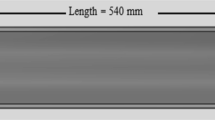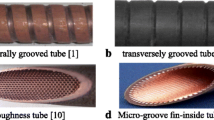Abstract
In this paper, the effects of dimensionless gas area fraction (δ) and normalized groove-rib periodic spacing (Λ) on developing flow for Newtonian fluid past circular tube having alternating superhydrophobic transverse grooves were numerically investigated. Fluid flow at Re ranging from 0.001 to 10 over various superhydrophobic microstructures scales (0.05 < Λ < 1, 0 <δ < 1) were studied. Numerical results show that the presence of superhydrophobic transverse grooves would consistently yield a longer hydrodynamic entrance length (Lh) as compared to that of smooth surface. This is principally owing to the flow redistribution with higher flow rate that is permitted in the vicinity of the superhydrophobic wall. However, the scale of the superhydrophobic transverse grooves yield non-monotonic trend on hydrodynamic entrance length, with reduced delaying effect at higher Λ. Despite the Lh alteration, Lh arising from the presence of superhydrophobic transverse grooves in tube of diameter D, at low Re (i.e., Re < 1), is still bounded within tube length of D.
Similar content being viewed by others
Abbreviations
- D :
-
Tube diameter
- E :
-
Groove-rib spacing
- e :
-
Groove spacing
- L h :
-
Entrance length
- N r :
-
Number of grid points in r-direction
- N z :
-
Number of grid points in z-direction
- p :
-
Pressure
- r :
-
Radial coordinate
- Re :
-
Reynolds number
- U avg :
-
Average velocity
- U FD :
-
Fully-developed velocity
- u r :
-
Radial velocity component
- u z :
-
Axial velocity component
- u θ :
-
Azimuthal velocity component
- z :
-
Axial coordinate
- δ :
-
Gas area fraction
- Λ:
-
Normalized groove-rib spacing
- λ :
-
Slip length
- μ :
-
Dynamic viscosity
- ν :
-
Kinematic viscosity
- ρ :
-
Liquid density
References
B. Atkinson et al., Low Reynolds number developing flows, AIChE Journal, 15(4) (1969) 548–553.
F. Durst et al., The development lengths of laminar pipe and channel flows, Journal of Fluids Engineering, 127(6) (2005) 1154–1160.
J. Bico, C. Marzolin and D. Quéré, Pearl drops, Europhysics Letters (EPL), 47(2) (1999) 220–226.
E. Karatay et al., Control of slippage with tunable bubble mattresses, Proceedings of the National Academy of Sciences, 110(21) (2013) 8422–8426.
K. Liu and L. Jiang, Bio-inspired self-cleaning surfaces, Annual Review of Materials Research, 42(1) (2012) 231–263.
D. Maynes, B. W. Webb and J. Davies, Thermal transport in a microchannel exhibiting ultrahydrophobic microribs maintained at constant temperature, Journal of Heat Transfer, 130(2) (2008) 022402.
R. Enright et al., Isoflux nusselt number and slip length formulae for superhydrophobic microchannels, Journal of Heat Transfer, 136(1) (2013) 012402.
K. W. Hwang et al., Effects of heat flux on dropwise condensation on a superhydrophobic surface, Journal of Mechanical Science and Technology, 30(5) (2016) 2141–2149.
J. W. Oh et al., Characteristics analysis of the developed surface modification technologies to improve the anti-corrosion performances for offshore equipments, Journal of Mechanical Science and Technology, 33(8) (2019) 3971–3979.
E. Lauga and H. A. Stone, Effective slip in pressure-driven Stokes flow, Journal of Fluid Mechanics, 489 (2003) 55–77.
J. Davies et al., Laminar flow in a microchannel with superhy-drophobic walls exhibiting transverse ribs, Physics of Fluids, 18(8) (2006) 087110.
C. J. Teo and B. C. Khoo, Analysis of stokes flow in microchannels with superhydrophobic surfaces containing a periodic array of micro-grooves, Microfluidics and Nanofluidics, 7(3) (2008) 353.
C.-H. Choi and C. J. Kim, Large slip of aqueous liquid flow over a nanoengineered superhydrophobic surface, Physical Review Letters, 96(6) (2006) 066001.
J. Ou, B. Perot and J. P. Rothstein, Laminar drag reduction in microchannels using ultrahydrophobic surfaces, Physics of Fluids, 16(12) (2004) 4635–4643.
Y. P. Cheng, C. J. Teo and B. C. Khoo, Microchannel flows with superhydrophobic surfaces: effects of Reynolds number and pattern width to channel height ratio, Physics of Fluids, 21(12) (2009) 122004.
K. H. Yu, C. J. Teo and B. C. Khoo, Linear stability of pressure-driven flow over longitudinal superhydrophobic grooves, Physics of Fluids, 28(2) (2016) 022001.
Z. Duan and Y. S. Muzychka, Slip flow in the hydrodynamic entrance region of circular and noncircular microchannels, Journal of Fluids Engineering, 132(1) (2009) 011201.
Y. S. Muzychka and R. Enright, Numerical simulation and modeling of laminar developing flow in channels and tubes with slip, Journal of Fluids Engineering, 135(10) (2013) 101204.
L. L. Ferrás et al., Development length in planar channel flows of newtonian fluids under the influence of wall slip, Journal of Fluids Engineering, 134(10) (2012) 104503.
Z. Kountouriotis, M. Philippou and G. C. Georgiou, Development lengths in Newtonian Poiseuille flows with wall slip, Applied Mathematics and Computation, 291 (2016) 98–114.
W. Gong et al., Effects of slip length and hydraulic diameter on hydraulic entrance length of microchannels with superhydrophobic surfaces, Frontiers in Energy, 14(1) (2020) 127–138.
S. K. Ranjith, B. S. V. Patnaik and S. Vedantam, Hydrodynamics of the developing region in hydrophobic microchannels: a dissipative particle dynamics study, Physical Review E, 87(3) (2013) 033303.
N. Ma et al., Lattice boltzmann simulation of the hydrodynamic entrance region of rectangular microchannels in the slip regime, Micromachines, 9(2) (2018) 87.
Acknowledgments
The authors acknowledge the Ministry of Education (MOE) of Malaysia under Fundamental Research Grant Scheme (FRGS Grant: FRGS/1/2019/TK03/USM/03/3) for the financial support.
Author information
Authors and Affiliations
Corresponding author
Additional information
Kok Hwa Yu received his B.Eng. (Hons) and M.Sc. degrees in Aerospace Engineering from Universiti Sains Malaysia in 2008 and 2011. He received his Ph.D. in Mechanical Engineering from National University of Singapore. He is currently a Lecturer in Universiti Sains Malaysia. His research interests include fluid dynamics, mixing flow, microfluidics and heat transfer.
Han Wei Lee received his B.Eng. (Hons) in Mechanical Engineering from Universiti Sains Malaysia in 2018. He is currently pursuing a Master’s on fluid dynamics in School of Mechanical Engineering, Universiti Sains Malaysia.
Yew Heng Teoh is a Lecturer at Universiti Sains Malaysia (USM), Malaysia. He received his Ph.D. in Mechanical Engineering from Universiti Malaya (UM), Malaysia, and both of M.Sc. and B.Eng. in Mechanical Engineering from USM. His research interests include combustion & fuel engineering, biofuels, automotive, internal combustion engines, and control systems engineering.
Mohd Azmi Ismail received the Bachelor’s and Master’s in Mechanical Engineering from Universiti Sains Malaysia, Engineering Campus, Nibong Tebal, Penang, Malaysia. His Doctorate is from Kingston University, United Kingdom. His areas of expertise are electronic cooling, anti-Icing, spillway dams, CFD and air-conditioning.
Rights and permissions
About this article
Cite this article
Yu, K.H., Lee, H.W., Teoh, Y.H. et al. Developing flow of Newtonian fluids over superhydrophobic transverse grooves in circular tube. J Mech Sci Technol 35, 199–207 (2021). https://doi.org/10.1007/s12206-020-1219-8
Received:
Revised:
Accepted:
Published:
Issue Date:
DOI: https://doi.org/10.1007/s12206-020-1219-8




